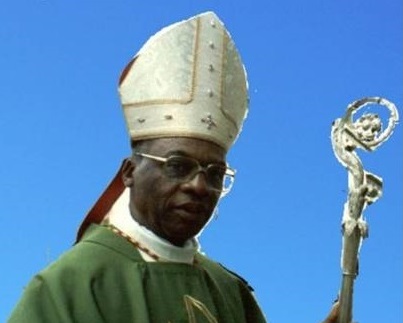Memoirs of Cardinal Rugambwa: His Last Journeys to Europe and Bukoba
By
Fr. Stanislaus Mutajwaha, PhD
Catholic Diocese of Bukoba, Tanzania
(Writing from USA)
Conclusion:
I considered it fitting to post the
conclusion of my short “Memoirs of His Eminence” at this time when we are
remembering his 100th Birthday. But as I said at the opening, my memoirs were
going to cover a very limited segment of his Eminence’s life, extending over a
period of less than two months as I escorted him from Dar es salaam on his last
journey to Europe and again on his last one to Bukoba. I hope more will continue to be said and
probably much more still will be published by this blog or some other
initiative to give a more comprehensive and wholesome picture of His Eminence
for the benefit of posterity. This way, our generation that was lucky to have
known him, learned something constructive from him or even probably in one way
or another participated in reaping some of the fruits of his sweat will feel
satisfied for trying to do him the justice he truly deserves as a token of our
gratitude.
Given the nature and limited scope
of my memoirs anybody would laugh if I tried to draw from the limited facts a
conclusion that claims to summarize the complete story of this great man. I can therefore only repeat that these
memoirs are just an aspect of a larger picture. Still, I think that when
properly handled, especially in the light of many other generally known facts
the few insights drawn from our limited aspect can serve as a reliable window
to interpret the weight and meaning of the larger story itself. That being the
case starting from our memoirs we can legitimately attempt general reflections
on the life and achievements of His Eminence as a religious leader and shepherd.
And this is what this conclusion is all about.
But while planning to conclude my
memoirs with reflections rather than making an additional narrative (that someone
could read over very fast like a paragraph in a novel) I thought it was even
more appropriate putting those reflections concisely in a style that stands
somewhere closer to poetry than prose. It is a kind of Birthday Message in the
memory and honor of Rugambwa His Eminence who, while he has preceded us into
the other side of life remains dear to all of us as model, inspiration and
challenge. This message hinges on the fact that while he ascended the heights
of office and honor he did not forget his brothers and sisters. On the contrary, he used his position to work
for the betterment of their condition at all levels, spiritual and social. But
finally let there be no ambiguity: those
“brothers and sisters” he strived to
minister are inclusive, because for His Eminence, like anybody else who has the right
understanding of human existence, the world
of brothers and sisters extends beyond the borders of a region, nation or
continent. For that reason His Eminence could rightly be called a Prince of the
Church.
A reflective poem by Fr. Stanislaus Mutajwaha
(NOTE: Read from the first line left to the first line right then second line left to second line right and proceed in that order)
A Moment of Reflection
on the occasion of the 100th Birthday of
Laurean Cardinal
Rugambwa;
Exemplar of humble service
Laurean Cardinal Rugambwa,
His Eminence;
Leader and exemplar of humble service
A century today, great
child was born;
His mother was there, the event in
memory to fix
Unleash your joy, Happy
Birthday to sing;
For this day saw, his mother’s
broadest smile
Rugambwa who came, from
villages low;
To ascend the heights, eye for
brother with him
Education he sought, when few
would dare;
Fruit of which was dear, and gain no
cheap
After years of work, his
aspiration became;
A choice very fine; and a blessing
for all
New vigor he brought, to
his Master’s vineyard;
Like a fresh artist eager, to sing
his aria
Committed to serve, and as
priest to live;
Would never give in, from purpose to
waver
At an hour foreknown,
though only by God;
His star would rise, bells of joy
would go
Rugambwa the priest,
really rose in fame;
But for his brother, never remained
aloof
Duty first at heart, his
flock to graze;
By example he taught, how to grow in
faith
Increase of fame, misled
him not;
Foremost a priest, his soul’s
desired plateau
Neither wealth nor might, he
considered a goal;
No glitter or litter, derailed his
aim
At the helm as leader, he
found his rise;
But in stooping to serve, he felt no
ebb
Like those who think, all giving
is virtuous;
His Eminence gave, be little but all
Rugambwa did care, his
gifts to share;
Whichever his measure, the returns
were double
Unlock his log, his legacy
to view;
What a story so deep, mostly written
in deeds
Gauge well and see, for
like many he rose;
But fewer like him, in honor compare
All guilds teeming, schools
and churches;
Hospitals booming, and more so ever
Many achievements made,
but key how simple;
Any little he got; for brother would
giv’
But now it’s time, for
wreath and garland;
Our prayers to send, all, you and I
When hosts of saints, that
dawn ’l assemble;
Lord reward his love, with joy
beatific
Angels receive him, and show
him in;
To
take his place, in eternal abode.
